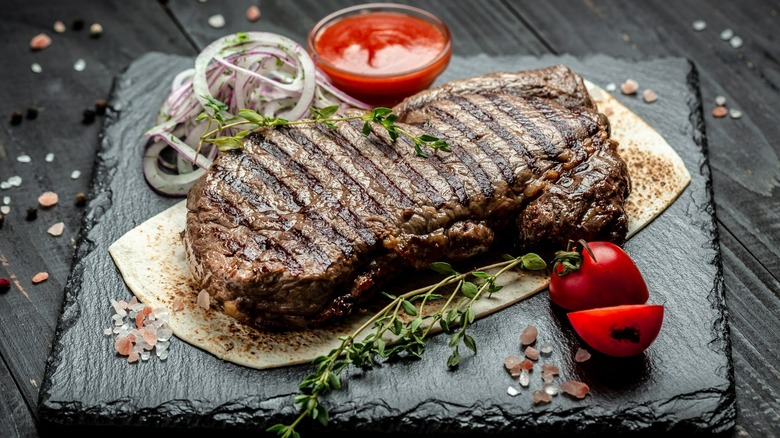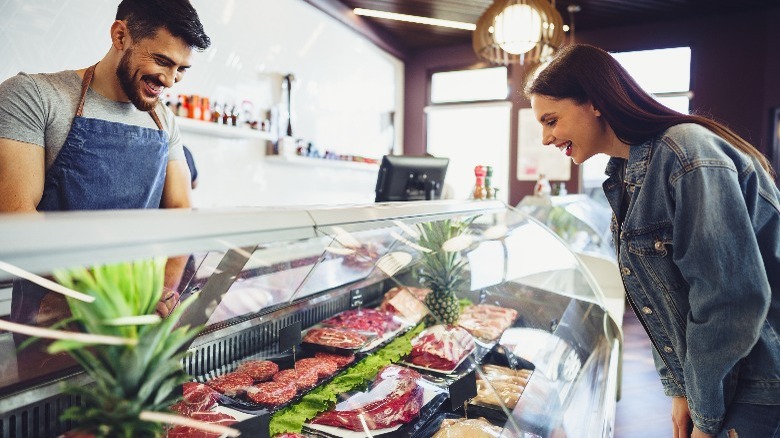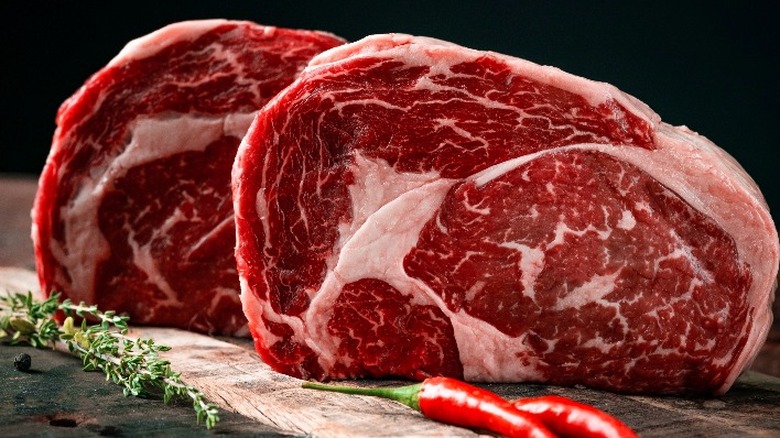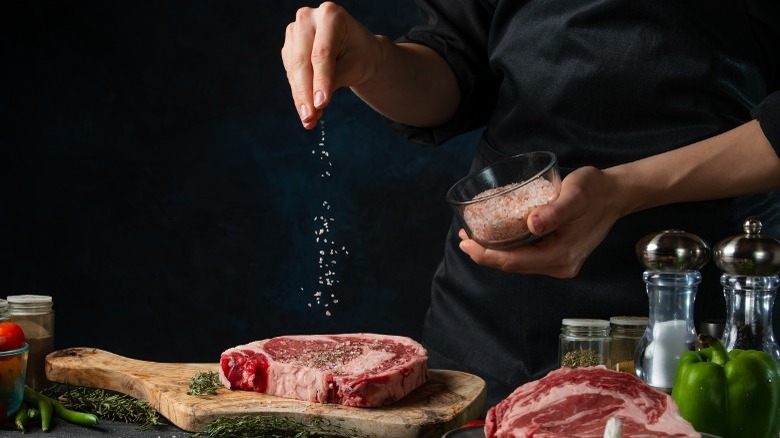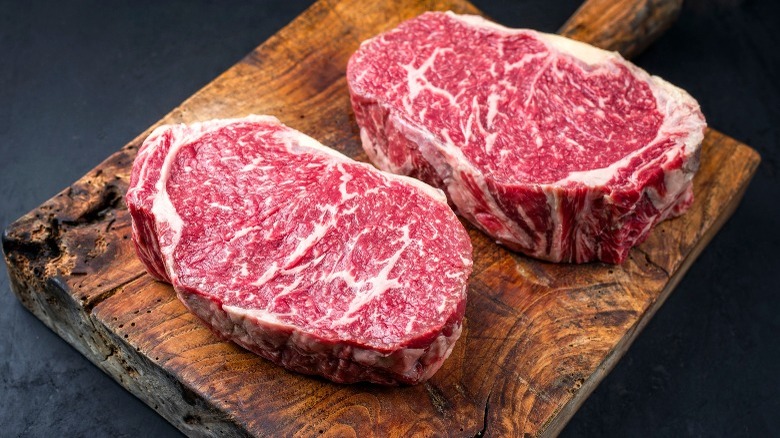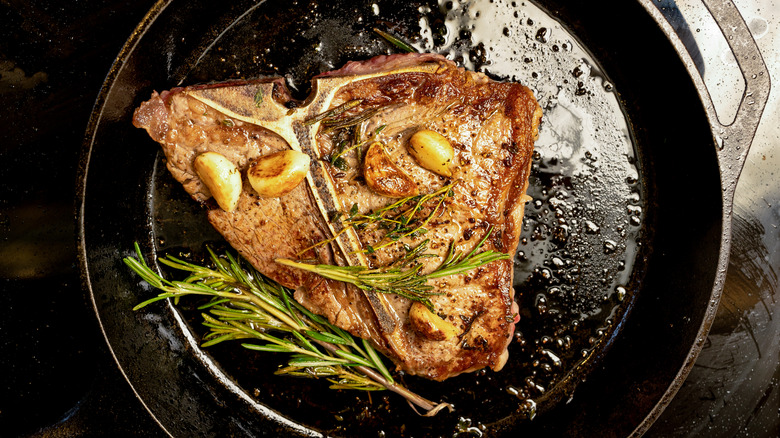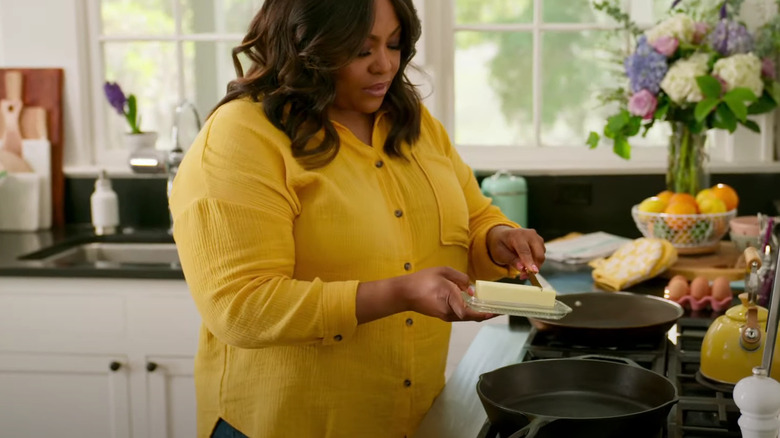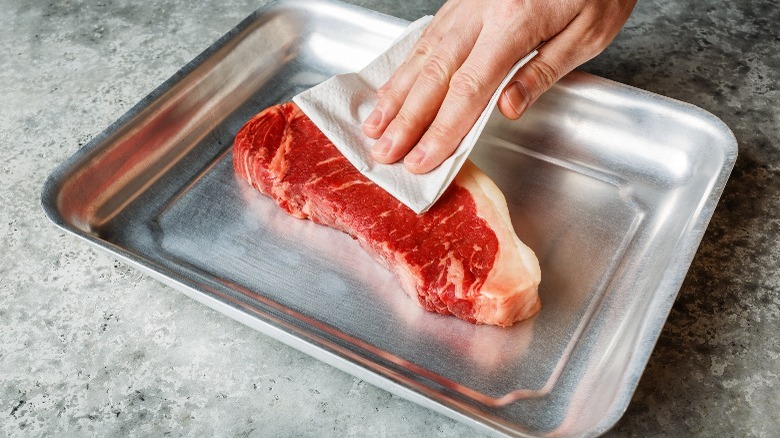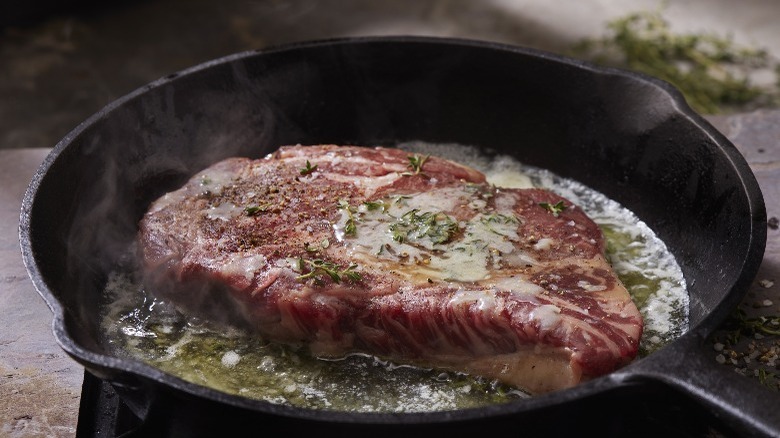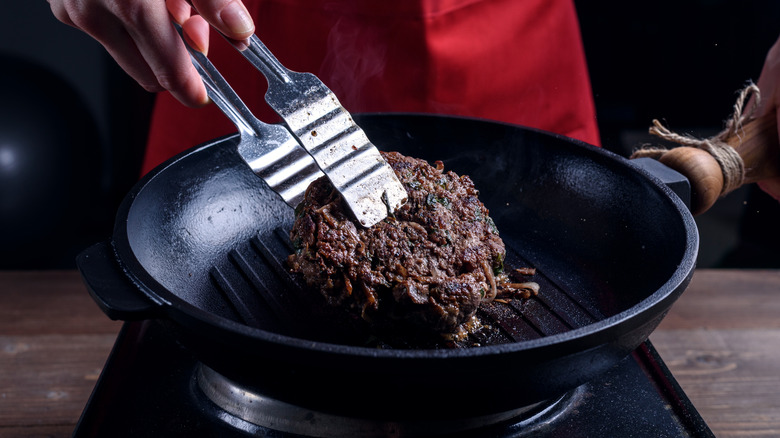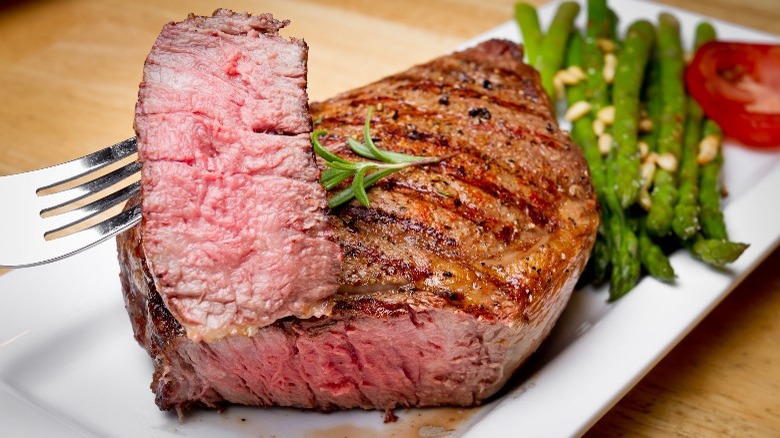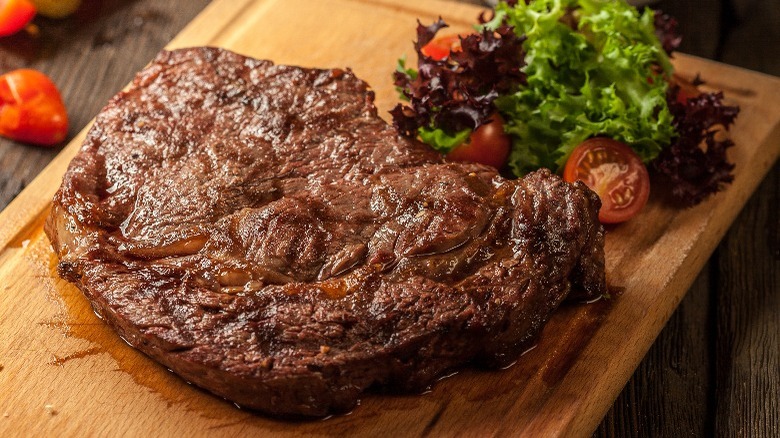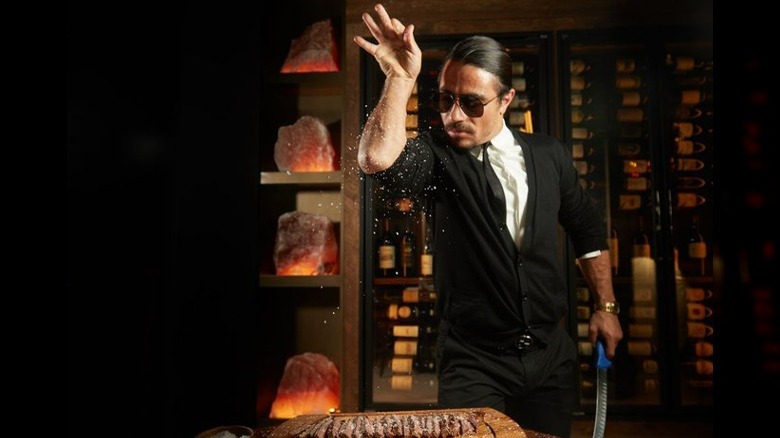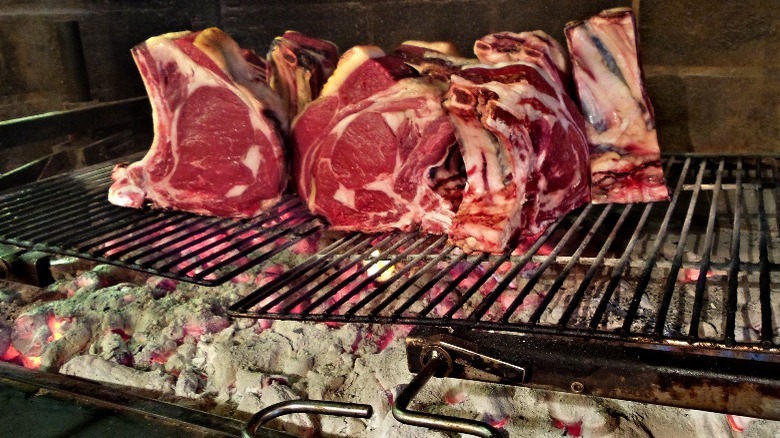Tips On How To Cook The Perfect Steak From Celebrity Chefs
Cooking the perfect steak can feel like an almost impossible task for many home cooks. Often, you end up with meat that's either undercooked, overcooked, too tough, too dry, too bland, or just generally not as good as the big, juicy melt-in-your-mouth slabs you get at your favorite steakhouse. So what's the secret? How are chefs nailing the perfect steak every single time when it sometimes feels like such a hit-or-miss endeavor at home?
It turns out the secret isn't as complicated as you might imagine. There's no fancy equipment or complicated trick. You don't even need to splurge on the most expensive cut of meat — although it doesn't hurt. Instead, just try these simple tips to sear the perfect steak at home from celebrity chefs like Samin Nosrat, Gordon Ramsay, and Diva Q. If you follow these various processes, you'll be able to recreate restaurant-quality results every time you're craving a hearty steak dinner.
Become friends with your local butcher to make getting the best cut easier – Hilary Henderson
To get the best cut of meat — or to figure out your favorite cut if you're new to the game — it helps to have a friendly relationship with your butcher. At least, that's what Hilary Henderson, chef de cuisine at CUT by Wolfgang Puck in Los Angeles, recommended in an interview with Robb Report.
As a chef at one of the best steakhouses in the United States, she knows that a big reason steaks taste better at a restaurant is because they cultivate strong, long-lasting relationships with their meat suppliers to ensure they're getting high quality cuts.
Henderson suggests heading to a local butcher shop or even the butcher at your grocery store and sparking up a conversation. Ask questions about what they have in stock that day, and what they might buy for themselves.
Not only do they know what the highest quality cuts they have in stock are, but they can also recommend the best cut for your price range and potentially even give you tips on the best way to cook it. If you're overwhelmed by all the different cuts you see recommended online and even more by the conflicting information about different grades, how thick it should be, or whether to go for bone-in or boneless, a friendly butcher is your best ally for navigating the meat case.
Look for marbling and flecks of fat in the meat – Diva Q
If you don't have time to get friendly with your local butcher ahead of your next cookout, but you're still not sure which cut of beef to get, follow the advice of Danielle Bennett, aka Diva Q. In a Traeger Grills YouTube video, the world champion pitmaster and host of Travel Channel's "BBQ Crawl" said to pick something with lots of marbling and flecks of fat.
Regardless of grade, cut, or any other criteria, the key to a great steak is plenty of fatty streaks in between the muscle that will melt and infuse into the red meat as it cooks. That's what gives a steak its juiciness and tenderness while also bringing out its beefy flavor.
Chefs disagree a lot about what the best cut of meat is for a steak. Some say it's ribeye while others swear by porterhouse or filet mignon. But one thing they're all looking for in the cuts they proclaim their favorites is lots of marbling. So find the best cuts in your price range, and then pick the one with the most streaks of white fat in it.
Salt the steak the night before you plant to cook it – Kamini Pather
MasterChef South Africa Season 2 winner and host of "Girl Eats World," Kamini Pather told viewers in UCOOK Facebook video that she always starts the process of cooking a steak the night before. Pather recommends seasoning the meat generously with salt, pepper, and garlic before leaving it in the fridge overnight — and no, she doesn't cover it.
This method is sometimes called dry brining, and you can do it with the seasoning blend Pather uses or with your own preferred blend. Just make sure you're using plenty of salt because that's the ingredient that's working the magic overnight.
During the time it spends in the fridge, the salt will penetrate deep into the meat to season it from the inside out. But, more importantly, it will break apart the proteins and lock in moisture for a juicier, more tender steak.
Let the steak rest at least 10 minutes at room temperature – Gordon Ramsay
When you're ready to actually begin cooking the steak, you may be tempted to just grab it right out of the fridge and set it right in your pan. Unless you want to invoke the wrath of Gordon Ramsay, you should not do that. The celebrity chef of "Hell's Kitchen" fame told viewers in a YouTube video that the meat should be at room temperature before you put it in the pan.
Pull it out of the fridge at least 10 minutes before you plan to cook it. If you put cold meat into a hot pan, the fibers tense up, and you can end up with a tough steak. It can also result in an uneven cooking process, with some spots undercooked while others are overdone.
To engrain this habit into your steak cooking routine, pull the meat out of the fridge right before you start heating up your cast iron. By the time your pan is hot enough, your steak should be warm enough to cook.
Preheat your cast iron in the oven first to get it hot enough for a sear – Samin Nosrat
Pretty much every chef you ask will agree that you need a screaming hot pan to get that perfect sear on your steak. But cast iron takes what feels like years to heat up, even some of the most patient home cooks can end up adding the steak too early.
A good way to speed up the process, according to Samin Nosrat, is to preheat your cast iron in the oven first. The "Salt, Fat, Acid, Heat" author recommends preheating the oven to 500 degrees Fahrenheit and then leaving your pan in there for about 20 minutes. That should get it piping hot, so once you put it on the stove over a high flame, it'll be ready to sear your steak.
The oven preheating step is a key step for home cooks trying to recreate a restaurant-quality steak. Professional kitchens are generally working with stove tops pumping out as much as 25,000 British Thermal Units (BTUs) while burners on a standard home stove top typically range somewhere between 500 and 18,000 BTUs. So even if your stove is at the high end of that range, it's still not going to be able to heat up a pan as quickly or to as high a heat as chefs can achieve in a professional kitchen. The oven trick is a way to reliably reach those super high temperatures at home so that all your stove top has to do is help the pan maintain that heat.
Add lots of butter to the pan – Kardea Brown
When Kardea Brown is cooking a steak, she likes to add plenty of butter to the pan after it's hot so she can baste the meat while she's searing to infuse it with even more flavor. The chef and "Delicious Miss Brown" host also adds fresh rosemary sprigs to the pan just before the steak so that the herb can impart some of its earthy flavors into the butter that she's basting the steak in. That step isn't a must, but it will take your steak up a notch.
While some say it's better to sear the steak in olive oil since it has a higher smoke point than butter, you won't get the same rich, creamy layers of flavor. You'll still get a great steak, though. And you can use Brown's fresh herb infusion trick with either option. So choose your preferred fat and add a generous helping of it to the pan a minute or so before you add your steak.
Pat the steak dry after seasoning and before putting it in the pan – Jet Tila
In order to get a really nice sear on the outside of your meat, it needs to be dry. Moisture and the pan "don't play well together," according to Chef Jet Tila. This is true whether you're searing, grilling, or frying.
So follow the celebrity chef's advice and pat both sides of the steak with a paper towel to get rid of any excess moisture on the outside of the meat before you put it in the pan. Patting steak dry ensures that a crust starts to form the moment your steak touches the pan by enabling the Maillard reaction.
The Maillard reaction is the chemical change that happens to proteins and sugars when exposed to extremely high heat. Basically, it's the process that creates that delicious crust on the outside of your steak when you sear it.
If there's moisture on the outside of your meat, the hot pan has to evaporate that before it can reach the proteins and sugars on the surface of your steak. That means it will take longer for the crust to form, which means your steak will have to spend more time in the pan. That puts you at risk of overcooking it in pursuit of the perfect crust.
Don't flip the steak until you see a crust forming along the bottom edge – Giada De Laurentiis
Before Giada De Laurentiis achieved global fame with her daytime cooking show, "Everyday Italian," the chef worked Wolfgang Puck's flagship restaurant, Spago so she's definitely comfortable around a steak. On Instagram, she told her followers to leave the steak alone once it's in the pan. Instead of moving it around or constantly flipping it, just let it sit in the hot pan until it starts to form that perfect crust.
She says it can take about three or four minutes for this to happen, but what you're looking for is evidence of a crust along the bottom edge of the steak. Not only does the crust add incredible flavor to your steak, but Laurentiis says it also suspends the steak just above the pan.
That suspension means you'll be able to pick it up and flip it without ruining the crust you just made. If you're struggling to tell whether the crust is done and it's ready to flip, use that suspension as your guide. When you think it might be ready, grab a pair of tongs and gently try to lift the steak away from the pan. If it lifts up easily, it's probably ready to flip.
Flip and do the same for the other side. When the other side lifts away from the pan easily, it's ready to come off the heat and rest on a plate.
Or flip your steak every 10-15 seconds – Heston Blumenthal
While Laurentiis and other chefs insist that you should only flip a steak once, letting each side stay on the pan until the crust is fully formed, there are other schools of thought. For example, Heston Blumenthal, the British celebrity chef, flips his steaks constantly.
According to Blumenthal, you should flip the steak every 10 to 15 seconds to avoid letting the heat penetrate too deeply into the meat. By exposing each side to short pulses of heat, you can still get a nice crust on the outside, but you give the meat beneath that crust time to cool off in between those searing sprees.
It's a solid technique for those who prefer their steak on the rare end of the spectrum. If you want it charred on the outside and pink in the middle, ensuring that it doesn't get exposed to heat for too long is the key. Preheating your cast iron until it's screaming hot is the best way to guarantee that outcome. But regular flipping as Blumenthal recommends can provide some extra insurance that you won't overcook your steak.
Whether you flip once or flip constantly, though, the goal is to never have to scrape your steak off the cast iron, which can leave the crust on the bottom of your pan instead of on your steak.
Use Carla Hall's trick for checking the doneness of steak without cutting it
One of the trickier aspects of searing a steak is knowing when it's done. No recipe can give you an exact cooking time here because it really depends on how thick your steak is — and how done you want it. Fortunately, there are a few ways to test for doneness, so you can make sure to pull your steak off of the heat as soon as it reaches your desired level of doneness.
Most methods call for piercing it with a thermometer or cutting into it to check the color. But if you don't want to damage your precious crust, use this handy trick courtesy of Carla Hall, the chef who rose to fame after competing in two seasons of "Top Chef." According to Hall, you can ball your hand into a fist and compare the tension in the ball of your hand to the tension of the steak to gauge doneness.
For a rare steak, for example, just fold your fingers down over your palm. Poke the ball of your hand by your thumb with your other hand. Then poke the steak to see if it feels the same. For medium rare, lightly press your fingertips into your palm. For medium, tighten your fingers a little further. For medium well, tighten them even further. For well done, tighten them into a fist like you're ready to punch someone.
Don't f***ing touch it – Anthony Bourdain
Your steak isn't done when it comes off of the pan. It still needs to rest for anywhere from five to seven minutes. During that time, leave it alone, according to the late, great Anthony Bourdain. Don't poke it or slice it, not even to check the doneness. Just let it rest, uncovered, at room temperature.
The "Kitchen Confidential" author and host of multiple food travel series says that this final resting period is absolutely essential. During that rest, the juices inside the steak will redistribute throughout the meat so that every delectable bite you take is juicy, tender, and packed with flavor. If you skip this resting period and slice into the hot steak right away, all those delicious juices will leak out.
Perhaps more importantly, Bourdain says, the meat also continues to cook a bit from the residual heat while it's resting. So those extra few minutes can help even out any undercooked spots so that the steak is your preferred level of doneness all the way throughout.
Salt it like Salt Bae – Nusret Gökçe
The world knows him as Salt Bae, the muscly man behind the steak salting meme, but Turkey knows him as Nusret Gökçe, a chef and restaurateur with a chain of successful steakhouses. His meme famous salting technique involves pinching salt — specifically Maldon flakes — between two fingers and sprinkling it across the steak from a height.
While it's been criticized as unnecessarily dramatic, it turns out there is a method to the Salt Bae madness. According to Eater, many expert chefs recommend holding your hand further away from your dish when salting it and using a pinching or wagging motion to scatter the grains or flakes across a wider surface area.
The admittedly flashy method ensures that the salt is spread evenly across the entire steak. If you salted the meat overnight like Kamini Pather recommends, this method can also minimize the risk of over-salting your steak. You don't need much salt at this stage since that overnight dry brining infused salt into the steak's interior. But you still want to finish it with a sprinkle of flakes to bring out the flavors of the crust you created through careful searing.
Or ignore everyone else and use Jose Andres' slow tempering trick for a juicy steak
The way most chefs tell it, you need a piping hot pan and a few minutes to get the perfect steak. But that's not the only way it's done. Celebrity chef Jose Andres does the exact opposite, in fact. According to Andres, the best way to cook a steak and ensure it's cooked to your preferred doneness is to temper the meat by starting it on low heat.
He does this by placing the steak about three feet above the coals on a grill. At that height, the meat is exposed to only a faint, radiant heat. They stay there until the steaks reach an internal temperature of 105 degrees Fahrenheit — or just below rare, if you'd rather test by poking it with your finger instead of a thermometer.
If you want a crust, place the tempered meat into a sizzling hot pan for a few seconds on each side to char it. If not, temper it to your preferred doneness and enjoy. Andres says there's no need to rest it first when you use this slow cook method.
